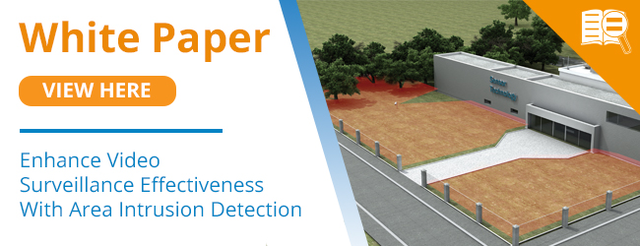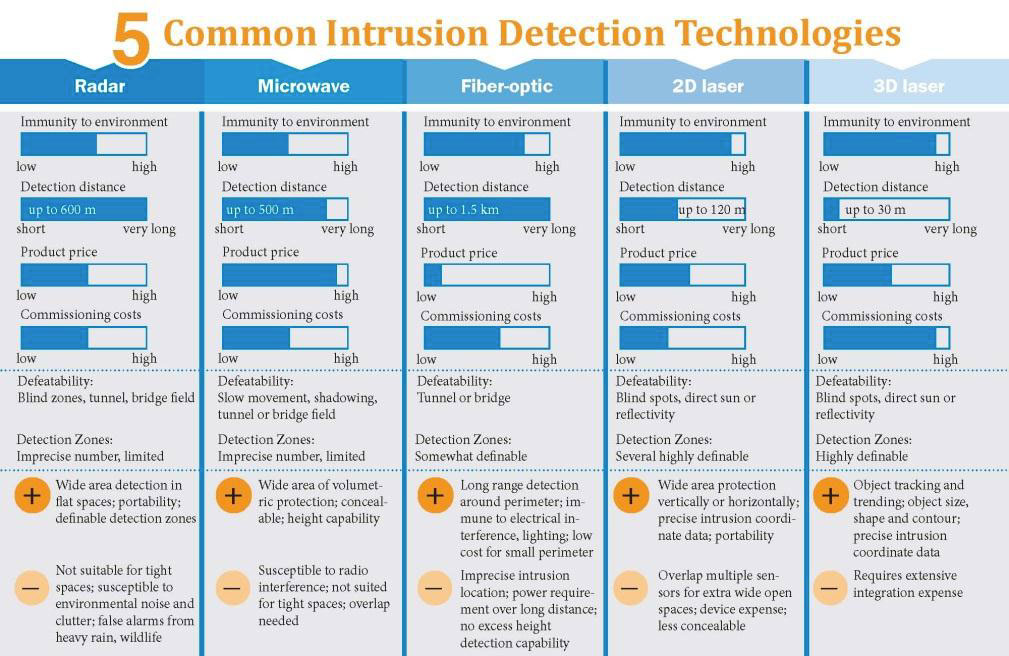
When building security systems with video analytics provide inconclusive or incorrect alarm signals, advanced video surveillance technology solutions provide the needed additional capacity to alert personnel to possible security breaches to ensure property and people are protected. The ability of detection sensing methods to isolate the precise location of an intrusion and communicate that information to video management systems drives the need for using a variety of technologies, such as laser measurement, radar, microwave, and fiber-optic solutions.
These five primary technologies are outlined as follows.
1. Radar
Radar works via transmitter and receiver in one housing when the detector sends electromagnetic waves and analyzes reflected echoes from target objects. Three dimensional volumetric sensors are used in a variety of applications including distance monitoring (fences) and area monitoring (such as roofs and parking lots). Radar technology has pros and cons. The benefits of radar security sensors include the ability to track speed, position, and direction of the objects detected up to 15 m high. Radar solutions are not suitable for tight detection zones (< 2 m). Nor is radar effective as line of sight technology since it lacks the capacity to determine what type or accurate size of object is detected. Since radars are affected by background or environmental noise data can be compromised.
2. Microwave
Microwave works with a separate transmitter and receiver units (or transmitter and receiver enclosed in a single housing). Microwave signals are transmitted and intrusion is detected through shifts in the received frequency. Like radar, microwave security is highly effective in distance monitoring (fences) as well as area monitoring (such as roofs and parking lots). Weather is always an issue, yet less with microwave technology and provides high sensitivity andmonitoring up to 15 m high and long distances from the sensors. Also similar to radar, microwave is not suitable for tight detection zones (< 2 m), and since any obstacle could cause a blind spot, line of sight is less effective.
3. Fiber-optic
Fiber-optic technology works when light waves sent between a transmitter and receiver are evaluated to determine changes in the light properties. Fiber-optic technology is most often used in perimeter monitoring including fences, solar panel fields, and pipelines. With low procurement costs, immunity from environmental factors, and a simple installation process, fiber-optic technology is often an effective added security choice, however higher installation costs must be considered.
4. 2D Laser (Lidar)
Two-dimensional laser measurement devices (Lidar) monitor areas with a sweeping laser beam, using the time-of-flight principle to accurately measure distances throughout the field of view. This technology is used in open spaces and with curtain control, such as vertical and horizontal structures or walls. Because light waves are resistant to environmental factors, false alarms are reduced. Configurable ranges, concealed mounting, and up to 360° scanning range in real-time ensure highly accurate detection and position information. Two-dimensional laser measurement can provide trend and track data for accurately controlling video devices. Commissioning and maintenance for outdoor installations is more cost efficient compared with other solutions. Two-dimensional laser measurement has a longer range than three-dimensional laser measurement systems, yet lacks a third measurement dimension for detection. There is a moderate initial hardware cost (although total cost of ownership is low) and it is harder to conceal than buried cables.
5. 3D Laser
Three-dimensional laser measurement is similar to 2D laser measurement, but adjusts frequency phase-shift technology to measure distance from scanner. It is used in short-range distances (less than 3 m) and often at retail counters. This newer technology may give pause for inclusion as part of an overall security strategy, however the resistance to environmental factors and adjustable ranges and detection areas may bode well for the future of this modality. Because this is still a new technology there is often a greater integration expense involved.
![]() To learn more, download the full white paper: Enhance Video Surveillance Effectiveness with Perimeter and Open Area Intrusion Detection
To learn more, download the full white paper: Enhance Video Surveillance Effectiveness with Perimeter and Open Area Intrusion Detection






